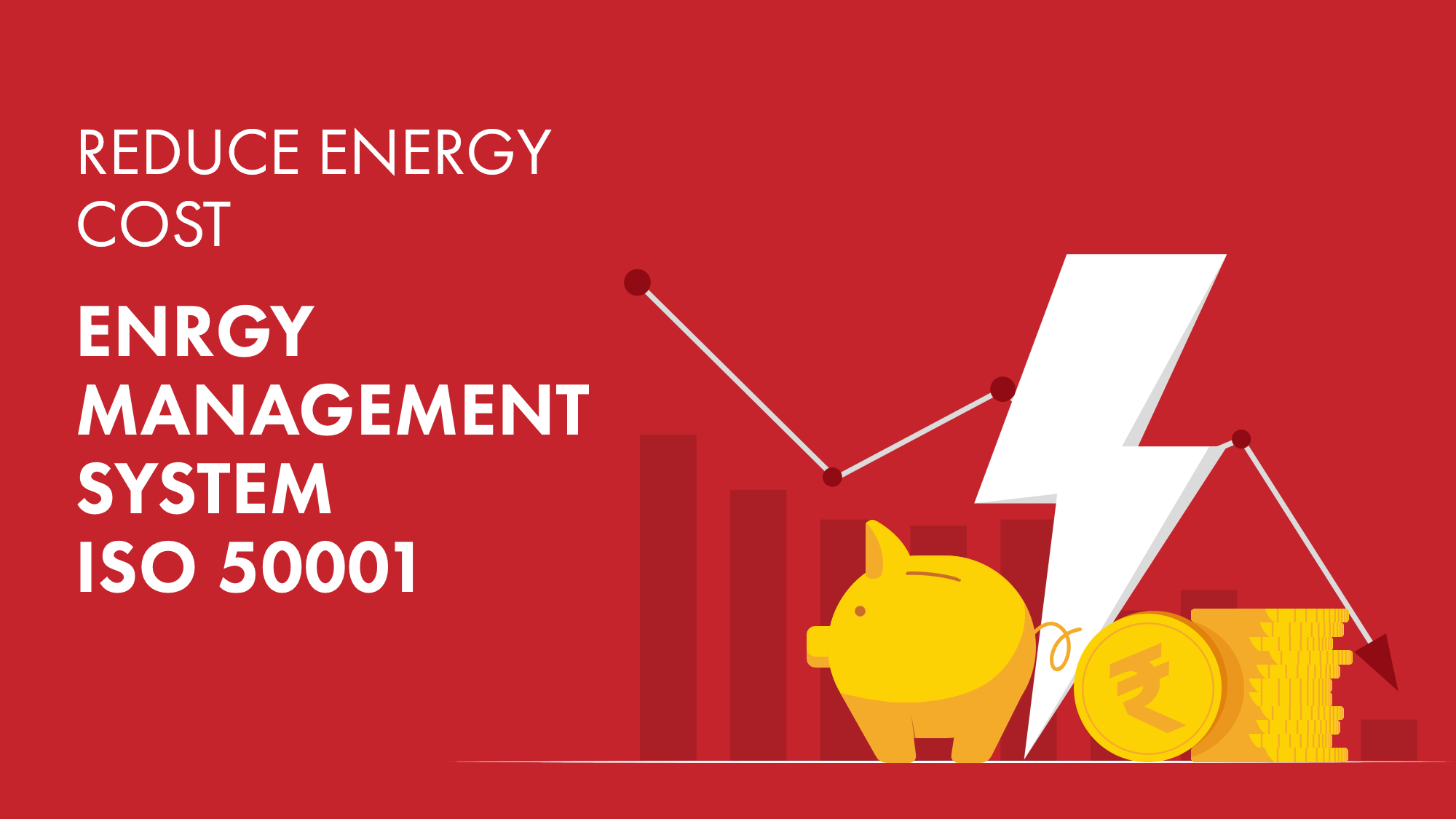
Reducing Energy cost with ISO 50001: Energy Management System
25th Apr, 2023
In today’s world, energy consumption has become a significant concern for both individuals and organizations alike. Reducing energy consumption not only helps save money on utility bills, but it also has a positive impact on the environment by reducing greenhouse gas emissions. ISO 50001 is a globally recognized standard that provides a framework for organizations to establish, implement, maintain, and improve their energy management systems. By adopting ISO 50001, organizations can reduce their energy consumption, improve their energy efficiency, and increase their energy cost savings. In this blog, we will explore the benefits of ISO 50001, how it can help reduce energy consumption, and what steps organizations can take to implement this standard.
What is ISO 50001 Energy Management system Standard and why we should implement it?
ISO 50001 is a globally recognized standard for energy management systems (EnMS) that provides a framework for organizations to improve their energy performance and reduce their energy consumption, costs, and greenhouse gas emissions.
ISO 50001 is an international standard for Energy Management Systems (EnMS). It was first published in June 2011 by the International Organization for Standardization (ISO). The standard provides a framework for organizations to establish, implement, maintain and improve an energy management system that is designed to enhance energy performance, reduce energy costs, and improve environmental performance.
ISO 50001 is based on the Plan-Do-Check-Act (PDCA) approach, which is a continuous improvement model widely used in quality management systems. The standard provides a systematic methodology for identifying, monitoring, and managing energy consumption and efficiency, as well as for identifying opportunities for energy savings.
ISO 50001 is applicable to all types of organizations, regardless of their size, industry or geographical location. It can be used by industrial, commercial or public sector organizations to manage energy more efficiently and effectively, and to reduce their energy costs and environmental impact.
By implementing ISO 50001, organizations can demonstrate their commitment to energy efficiency and environmental sustainability, and improve their reputation and competitiveness in the market. ISO 50001 certification is also recognized as a best practice for energy management by many governments and industries around the world.
Benefits implementing ISO 50001
The benefits and savings from implementing ISO 50001 can be significant and varied, and some of them are:
- Reduced energy costs :One of the primary benefits of implementing an EnMS under ISO 50001 is the potential for reducing energy consumption and lowering energy costs. By optimizing energy usage, identifying inefficiencies, and implementing energy-saving measures, organizations can save money on energy bills.
- Increased operational efficiency :Energy management systems can help organizations optimize their energy usage, which can lead to increased operational efficiency. By reducing energy waste and improving energy performance, organizations can enhance their productivity and profitability.
- Improved environmental performance :By reducing energy consumption, organizations can reduce their carbon footprint and contribute to a more sustainable environment. This could improve the company’s reputation and provide it a competitive edge in the market.
- Compliance with regulations :Implementing an EnMS under ISO 50001 can help organizations comply with energy-related regulations and laws. Penalties and legal concerns could be prevented in this way. Also some countries required, large companies to carry out energy audits and implement energy saving measures as part of Energy efficiency directives.
- Enhanced corporate social responsibility :Implementing ISO 50001 can demonstrate an organization’s commitment to environmental sustainability and corporate social responsibility. This can enhance its reputation among stakeholders, including customers, employees, and investors.
- Reduced carbon footprint :By reducing energy consumption and greenhouse gas emissions, organizations can contribute to global efforts to combat climate change and reduce their environmental impact.
- Better risk management :By implementing an EnMS, organizations can identify potential energy-related risks and take steps to mitigate them. This can help avoid energy-related disruptions, enhance business continuity, and improve risk management.
Overall, the benefits and savings from implementing ISO 50001 can be significant and varied, depending on the specific needs and goals of the organization. However, the benefits can often outweigh the costs of implementation, making ISO 50001 a worthwhile investment for many organizations.
Key Steps to implementing ISO 50001
ISO 50001 is an international standard that specifies the requirements for an energy management system (EnMS) to help organizations improve their energy performance and reduce energy consumption. Here are the key steps to implementing ISO 50001:
The first step is to obtain management support for implementing ISO 50001. This will involve creating awareness about the standard and its benefits, and gaining the commitment of top management to allocate the necessary resources.
- Establish an energy management systemAn energy management system (EnMS) should be established to manage the organization’s energy consumption and improve energy efficiency. This system should include procedures for energy monitoring, measurement, and reporting.
- Train employees :All employees should be trained on the organization’s energy policy and EnMS procedures. This will ensure that everyone is aware of the organization’s energy goals and how to achieve them.
- Develop an Energy Policy :An energy policy is a statement of an organization’s commitment to managing energy. The policy should be aligned with the organizations overall strategy, objectives and targets.
- Conduct an Energy Review :An energy review is a systematic assessment of the organization’s energy consumption and energy performance. The review should identify areas where energy is being wasted, and opportunities for improvement.
- Establish an Energy Baseline :An energy baseline is a measure of the organization’s energy consumption and performance at a specific point in time. It serves as a benchmark against which progress can be measured.
- Establish Energy Objectives and Targets :Energy objectives and targets should be set based on the results of the energy review and the energy baseline. Objectives should be specific, measurable, achievable, relevant and time-bound (SMART).
- Develop an Energy Management Plan :An energy management plan should be developed to outline the actions that will be taken to achieve the energy objectives and targets. The plan should include a description of the resources required, the responsibilities of personnel, and the timelines for implementation.
- Implement the Plan :The energy management plan should be implemented according to the timelines and responsibilities outlined in the plan. Resources should be allocated, and personnel should be trained to ensure that the plan is effectively implemented.
- Implement energy-saving measures :The organization should implement energy-saving measures, such as upgrading equipment and implementing energy-efficient practices.
- Monitor and evaluate performance :The performance of the EnMS should be regularly monitored and evaluated to ensure that it is achieving its goals. This will enable the organization to identify areas for improvement and make necessary adjustments to its energy management practices.
- Monitor and Measure Performance :The energy management system should be monitored and measured to ensure that it is achieving its objectives and targets. Performance indicators should be established to measure progress.
- Review and Continually Improve :The energy management system should be periodically reviewed to ensure that it is still relevant and effective. Lessons learned should be incorporated into the system to continually improve performance.
- Certification :Finally, organizations can seek certification from an accredited third-party certification body to demonstrate that they have implemented an effective energy management system in accordance with ISO 50001.
By following these steps, organizations can ensure compliance with ISO 50001 standards and achieve significant energy savings.
Understanding the ongoing benefits of energy cost savings with ISO 50001
So, by implementing ISO 50001, organizations can effectively manage and reduce their energy consumption, leading to significant energy cost savings.
One of the primary ways ISO 50001 helps organizations save on energy costs is by identifying and prioritizing energy-saving opportunities. Through an EnMS, organizations can analyze their energy use and identify areas where they can reduce consumption. These opportunities could include upgrading equipment, improving processes, or implementing energy-efficient technologies.
ISO 50001 also promotes the development of energy performance indicators (EnPIs) that enable organizations to track their energy consumption and identify areas where they are using more energy than necessary. By regularly monitoring and analyzing their EnPIs, organizations can identify trends and take corrective action to improve energy efficiency and reduce energy costs.
In addition to identifying energy-saving opportunities, ISO 50001 requires organizations to establish energy performance targets and develop action plans to achieve them. This ensures that energy management becomes an integral part of an organization’s overall strategy, and helps to drive continuous improvement in energy efficiency.
By implementing ISO 50001, organizations can also benefit from increased energy awareness among their employees, which can lead to a culture of energy conservation. This can result in additional energy savings through simple behavior changes, such as turning off lights and equipment when not in use.
Overall, ISO 50001 provides a comprehensive framework for managing energy use and reducing energy costs. By implementing this standard, organizations can benefit from increased energy efficiency, reduced operating costs, and improved environmental performance.
How can 4C help you achieve ISO 50001 Certification?
ISO 50001 EnMS standard enables organizations to utilize energy efficiently. Its strategic framework coupled with our experts can enable you to achieve the highest tangible benefits which can not only lead to maximize your profits and significant cost saving but also consistent improvement. Also, the ISO 50001 certification can give you credibility and respect for your contribution to climate change. At 4C, we have highly skilled professionals who can help you identify challenges, analyze your current energy consumption practices and modify in accordance with the ISO 50001 EnMS standard to consistently improve energy consumption in your organization. Contact us now
